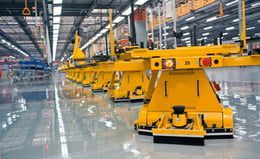Is Industry 4.0 Technology Worth the Cost?
Jesse Kelber - April 21, 2020

Industry 4.0 discussions are happening every day across industries. Some organizations are opting to roll out existing and emerging technologies in the hopes that they will see boosts to their ROI that justify the initial outlay, while others are taking a “wait and see” approach. It’s our strong opinion that spending what you can now to lay a solid foundation of Industry 4.0 technology is worth the investment, as long as you go about it strategically and intelligently. There are several aspects of this discussion that are key to remember when looking for facts to justify this spending. First, the infrastructure work can benefit all departments, which supports their ability to work efficiently and effectively. Second, this spending is about mitigating the cost of poor quality when it comes to your product or service.
What Is Downtime Costing You?
Industry estimates suggest that anywhere from 5-30% of a manufacturing organization’s revenue is lost to poor quality output. This statistic encompasses production machine downtime, out-of-compliance final product, rework, service calls, etc. I.e., any expense that is incurred as the result of production quality slipping. These costs don’t include the impact of losing customers, as those costs are hard to track. Let’s take a look at the automotive industry for a quick example: Estimates for the cost of machine downtime sit at roughly $22,000/minute. So if just one piece of equipment sits idle for an hour while a service tech is en route, that’s more than $1 million dollars lost. Imagine the impact on your bottom line if you could cut that by even 10%? Technology like IoT (Internet of Things) sensors that report on machine health and the predictive maintenance they allow can do this, and more.
Make Your Case with Use Cases
For the operations manager looking for buy-in from the C-suite, use cases like the one mentioned above are extremely effective bargaining chips. This holds especially true when they relate directly to your industry or sector. And in manufacturing, one of the easiest cases to make is the ability to perform predictive maintenance on production machinery. Industry 4.0, and the industrial internet of things (IIoT) specifically, is about cutting these expenses so you have that funding to put into growing your business. The devices associated with an IIoT factory are all about collecting and analyzing data. This data is then used to adjust capacity, perform that predictive maintenance, and eliminate the unexpected quality lapses that are costing you customers right now. Going back to our automotive example, if you can show a savings potential of $1 million/quarter by keeping your equipment in top shape, imagine how much easier it will be to justify spending $500,000 on the IIoT equipment now.
Iterate in Stages to Stagger Costs
As with any technology deployment, moving in stages that make sense to everyone is key. If you lay out your plan piece by piece, with associated costs and benefits to the company as a whole, your case will be that much easier to bring to a consensus. And since any Industry 4.0 initiative requires a robust IT infrastructure, we recommend starting there. Then, move on to upgrading strategic business solutions. Next, it’s time to implement the IoT layer, again being strategic so as to include the right stakeholders. Next in line is the analytics layer. This is where the power of artificial intelligence (AI) will take center stage, and with it will come holdouts and stakeholders who don’t understand what it is. Take your time here, explanations that are clear and concise will win you the supporters you’ll need.
Transparency Keeps Stakeholders On-Side
Nothing derails a project as fast as running into a stakeholder who feels blindsided by an impact on their division they weren’t ready for. Try to include representatives from all departments from each affected vertical and from all layers of the org chart in the process. Document each stage of the project and broadcast the location of that documentation to all involved. Hold regular brown bag events or Q&A panels with your project management team, and if that’s not possible then set up an email account or Slack channel dedicated to fielding questions and disseminating information. In order to keep costs low by eliminating the need for rework, and ultimately to see the best ROI possible, buy-in is crucial. Industry 4.0 is absolutely worth the cost—but only if you can deploy it with the full participation of all relevant stakeholders.
Production-On-Demand Is Coming
By powering predictive maintenance and mitigating disruptions, Industry 4.0 can create immediate cost savings. That said, Industry 4.0 paradigms are just as much about the future of manufacturing as the present--and the simple truth about manufacturing is that production-on-demand is the future. This is another area where an Industry 4.0 deployment can add value in the short and long term by supporting your transition to this model of production. By starting your journey now, you stand to benefit in several ways: first and foremost you’ll see ROI from lower downtime, increased production quality, and faster order turnarounds immediately. Beyond that, you’ll also be on the cutting-edge when on-demand hits full force, and you’ll able to have your facilities up and running fast to meet that growing demand for customized products. The infrastructure you have in place, combined with the IoT sensors on your factory floor, set you up for a smooth transition when you’re able to add the 3D printing capabilities needed for true production-on-demand.
Cost-cutting is on everyone’s mind in uncertain times. When it comes to Industry 4.0 adoption, the best option is often the one that requires some up-front spending in order to see massive returns in the future. By upgrading your infrastructure in this way, you establish the foundation in place for a robust IIoT (industrial internet of things) network. From there, you’re in a better position to add sensors and receivers to your production facilities, enabling the dataflows that you’ll need to enable predictive maintenance and optimize production capacity. From there, you’ll be perfectly positioned to add a layer of AI-powered advanced analytics to reap the most reward for your initial investments. So when it comes to answering the title question, “Is Industry 4.0 technology worth it?” our answer is a resounding YES. The details matter, however, and how you go about your digital transformation will lay the groundwork for how successful your transition will be and how quickly you’ll see the gains we’re talking about.
If you want to learn more get your Guide to Industry 4.0:
LATEST POSTS
- Understand Why Production Planning Needs Specialized Solutions
- Understand Circular Economy in The Manufacturing Industry
- How Can Industry 4.0 IT Integration Be Achieved Smoothly?
- The Significance of Order Sequencing in Discrete Manufacturing
- How to improve your Supply Chain Management: The Power of Control Towers



